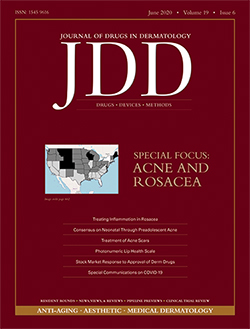Here are the June JDD Issue Highlights:
Guest Editor Dr. James Q. Del Rosso stresses that even the best case scenario of teledermatology can never offer the same as a live in-person visit in Virtual Exams No Substitute for In-Person Care of Acne and Rosacea.
Treating Inflammation in Rosacea: Current Options and Unmet Needs, authors discuss the underlying inflammatory nature of rosacea, treatments that target these inflammatory processes, and shortcomings of current therapies.
An expert panel of pediatric dermatologists and dermatologists provide information on differential diagnosis, prevention, treatment, and maintenance in Consensus on Neonatal Through Preadolescent Acne.
Tazarotene 0.045% lotion was efficacious and well tolerated in New Polymeric Once-Daily Tazarotene 0.045% Lotion Formulation for Moderate-to-Severe Acne: Pooled Phase 3 Pediatric Analysis.
Authors discuss a promising therapeutic option for improving scar appearance following surgery for NMSCs in Improving the Appearance of Surgical Facial Scars With IncobotulinumtoxinA and Microneedling.
A post, pooled analysis identified demographic characteristics associated with early response to crisaborole in Demographics and Baseline Disease Characteristics of Early Responders to Crisaborole for Atopic Dermatitis.
Retinol serum subjects showed significant week 4 improvement in visual skin smoothness in A Double-Blind, Comparative Clinical Study of Newly Formulated Retinol Serums vs Tretinoin Cream in Escalating Doses: A Method for Rapid Retinization With Minimized Irritation.
In Development of a Photonumeric Lip Health Scale, authorsevaluated the lips of 103 subjects to produce a photonumeric lip assessment scale that allows rating of health issues associated with 3 key lip characteristics: shine, texture, and vermilion border.
Isotretinoin use prior to onset of vitiligo was associated with decreased disease BSA, decreased odds of body and face involvement, and decreased co-morbid autoimmunity in The Effect of Isotretinoin on Vitiligo and Autoimmune Comorbidity.
FDA approval of dermatologic drugs generally has a positive market response in United States Stock Market Response to FDA Approval of New Dermatologic Drugs.
Treatment was safe and effective in patients with acne complicated by atrophic scars and genetically prone to post-acne scarring in Treatment of Moderate to Severe Acne and Scars With a 650-Microsecond 1064-nm Laser and Isotretinoin.
Patients who achieve total clearance with their biologic treatment may realize additional benefits and mortality beyond the patient-related outcomes of improved quality of life, more symptom-free days, and a reduction of symptoms in The New Psoriasis Paradigm: Striving for Complete Clearance.
Non-Steroidal Topical Therapy for Facial Seborrheic Dermatitis evaluates the effectiveness of a topical non-steroidal cream in treating facial seborrheic dermatitis including desquamation, pruritus, erythema, and stinging sensation.
Evaluating Population Interest in Vitiligo Through an Analysis of Google Trends and Social Media elucidates public knowledge patterns about vitiligo and general interest in vitiligo.
The June issue of JDD contains a section on Special Communications on COVID-19:
Concern exists for the possible deficits of manufacturing dermatology drug products from China, as well as the vast number of ingredients exported for use in the US in COVID-19 Supply Chain Considerations for Prescription Drugs in Dermatology.
Authors consider the potential impact on dermatology interview selection in Assessing a Paradigm Shift: Perceptions of the USMLE Step 1 Scoring Change to Pass/Fail.
Biologics and small molecules offer a promising role in management of severe cases of COVID-19 in Biologics and Small Molecules in the Treatment of COVID-19.
As telemedicine will likely become irreversibly more prevalent in our healthcare systems, the established cost-effectiveness, efficacy and limitations of the technology remain important to consider in preparation for its expanded role after this time of crisis Teaching Lessons from the Coronavirus Disease 2019 (COVID-19) Pandemic in Telemedicine.
Considerations of Managing Lichen Planopilaris With Hydroxychloroquine During the COVID-19 Pandemic addresses concerns about the dermatology drug shortage.
Outpatient Teledermatology Implementation During the COVID-19 Pandemic: Challenges and Lessons Learned discusses the real need to establish a reliable and widely available telehealth infrastructure.
Project AesCert Guidance Supplement: A Path to Aesthetic Care—Practical Considerations for Aesthetic Medicine Professionals Supporting Clinic Preparedness in Response to the SARS-CoV-2 Outbreak(First published in Dover, Moran, Figueroa et al. Facial Plastic Surgery & Aesthetic Medicine. 22:3;2020)is intended to provide aesthetic medicine physicians and their staff with a practical guide to safety considerations to support clinic preparedness for patients seeking nonsurgical aesthetic treatments and procedures following the return-to-work phase of the coronavirus disease 2019 pandemic, once such activity is permitted by applicable law.

